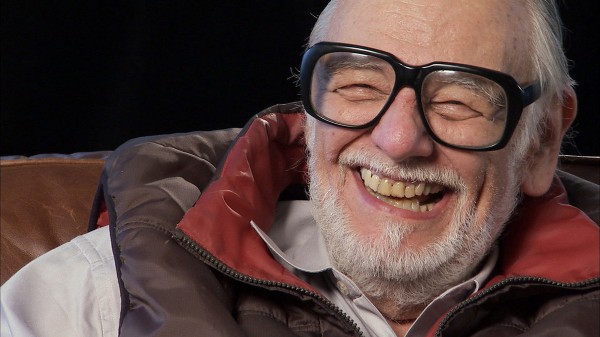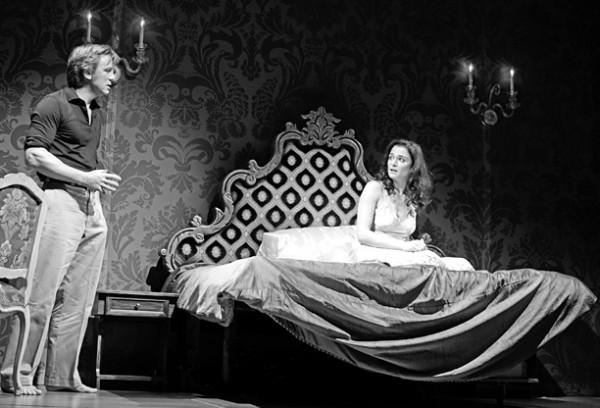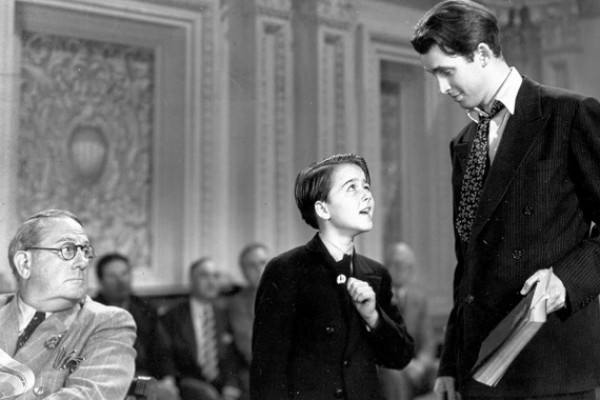
BAM hosts the New York premiere of Ballet Preljocaj’s apocalyptic “And then, one thousand years of peace” this week (photo © JC Carbonne)
BAM Howard Gilman Opera House
30 Lafayette Ave. between Ashland Pl. & St. Felix St.
November 7-9, $20-$55, 7:30
718-636-4100
www.bam.org
www.preljocaj.org
Ten years ago, Ballet Preljocaj performed Near Life Experience, an exploration of the body’s endless sensations. Now French choreographer Angelin Preljocaj brings his 2010 creation, And then, one thousand years of peace, to BAM, an evening-length journey into life and death courtesy of the apocalypse. “A fertile source of interpretation, the very word Apocalypse (from the Greek apo: ‘to lift’ and calypsis: veil’) evokes the idea of revealing, unveiling, or highlighting elements that could be present in our world but are hidden from our eyes. It should thus evoke what is nestled in the innermost recesses of our existence, rather than prophesizing about compulsive waves of catastrophe, irreparable destruction, or the imminent end of the world,” Preljocaj explains. “When dance, the art of the indescribable par excellence, assumes the role of the developer (in the photographic sense), is it not most able to realize this delicate function of exposing our fears, anxieties, and hopes? Dance relentlessly highlights the entropy of molecules programmed in the memory of our flesh that heralds the Apocalypse of bodies. It stigmatises our rituals and reveals the incongruity of our positions, be they of a social, religious or pagan nature.” The piece features twenty-one dancers moving in costumes by Igor Chapurin to music by DJ Laurent Garnier, along with Scan X mixes incorporating Benjamin Rippert and Beethoven. The set design, which includes inventive architectural elements, is by Subodh Gupta, with lighting by Cécile Giovansili-Vissière. Last month, the New York City Ballet presented the world premiere of Preljocaj’s Spectral Evidence, a dazzling work about the Salem Witch Trials, leaving fans hungry for more. And then, one thousand years of peace, a collaboration with the Bolshoi, should provide a visual and aural feast. Performances take place at BAM’s Howard Gilman Opera House November 7-9 at 7:30; in addition, company member Julien Thibault will teach a special class for experienced and professional dancers on November 8 at 12 noon ($25) at the Mark Morris Dance Center.

 “It was this tiny little movie in Pittsburgh that seemed to have no chance and it changed the world,” says Jason Zinoman at the beginning of Rob Kuhns’s extremely entertaining new documentary, Birth of the Living Dead. Zinoman, author of Shock Value: How a Few Eccentric Outsiders Gave Us Nightmares, Conquered Hollywood, and Invented Modern Horror, is one of several experts discussing the making, influence, and legacy of college dropout George A. Romero’s 1968 classic frightfest, Night of the Living Dead, which essentially invented the flesh-eating zombie. Throughout the documentary, the Bronx-born Romero, looking somewhat like a wide-eyed, white-haired Martin Scorsese, shares fascinating behind-the-scenes details about the creation of his masterpiece, describing how he raised what little funds he could, how most of the nonprofessional actors were members of the local community (steel workers, cops, meatpackers, ad executives, television hosts, etc.) who not only played ad-libbing humans or zombies but also supplied props, did the makeup, and donated equipment, and how no one really thought they’d ever actually finish and distribute the film, having previously specialized primarily in beer commercials and such authorized shorts as Mister Rogers Gets a Tonsillectomy — which Romero still considers his scariest work to date. Fans of Night of the Living Dead will glory in learning more about Harry and Helen Cooper (business partners Karl Hindman and Marilyn Eastman), newscaster Charles Craig, cemetery zombie Bill Hinzman, Sheriff McClelland (George Kosana), and others. While Romero says that the casting of Duane Jones as Ben was not based on race — and that not a word of the script was changed because Jones was black — a group of talking heads relates how it was a genius move not to make specific mention of race in the film, which was completed just before the assassination of Dr. Martin Luther King, Jr.
“It was this tiny little movie in Pittsburgh that seemed to have no chance and it changed the world,” says Jason Zinoman at the beginning of Rob Kuhns’s extremely entertaining new documentary, Birth of the Living Dead. Zinoman, author of Shock Value: How a Few Eccentric Outsiders Gave Us Nightmares, Conquered Hollywood, and Invented Modern Horror, is one of several experts discussing the making, influence, and legacy of college dropout George A. Romero’s 1968 classic frightfest, Night of the Living Dead, which essentially invented the flesh-eating zombie. Throughout the documentary, the Bronx-born Romero, looking somewhat like a wide-eyed, white-haired Martin Scorsese, shares fascinating behind-the-scenes details about the creation of his masterpiece, describing how he raised what little funds he could, how most of the nonprofessional actors were members of the local community (steel workers, cops, meatpackers, ad executives, television hosts, etc.) who not only played ad-libbing humans or zombies but also supplied props, did the makeup, and donated equipment, and how no one really thought they’d ever actually finish and distribute the film, having previously specialized primarily in beer commercials and such authorized shorts as Mister Rogers Gets a Tonsillectomy — which Romero still considers his scariest work to date. Fans of Night of the Living Dead will glory in learning more about Harry and Helen Cooper (business partners Karl Hindman and Marilyn Eastman), newscaster Charles Craig, cemetery zombie Bill Hinzman, Sheriff McClelland (George Kosana), and others. While Romero says that the casting of Duane Jones as Ben was not based on race — and that not a word of the script was changed because Jones was black — a group of talking heads relates how it was a genius move not to make specific mention of race in the film, which was completed just before the assassination of Dr. Martin Luther King, Jr.





 A huge critical and financial success in its native China, Zhao Wei’s romantic epic, So Young, will open the fourth annual New York Chinese Film Festival on November 5 at Alice Tully Hall. Adapted by screenwriter Li Qiang (Peacock) from Xin Yiwuit’s novel To Our Youth That Is Fading Away, the film follows a group of young women who meet at college, fall in and out of love with various young men, then look back at what could have been ten years later. The central focus is on Zheng Wei (Yang Zishan), an impulsive civil engineering freshman who is incensed by how she is treated by fellow architecture student and loner Chen Xiaozheng (Mark Chao). But soon her very public hatred simmers down as she tries to convince the very private Chen to be her boyfriend. Meanwhile, her roommates, campus beauty Ruan Guan (Jiang Shuying), clean freak Li Weijuan (Zhang Yao), and the butch Zhu Xiaobei (Liu Yase), go through their own problems as they all grow close. Award-winning actress and singer Zhao (So Close, Shaolin Soccer) makes a solid directorial debut with So Young, which takes its name from the song by Suede, although the film is overly long at more than two hours and gets confusing as it jumps around in time. But as the girls mature, so does the film itself, exploring social class, education, love, loyalty, ambition, and the many trials and tribulations that accompany the journey from childhood to adulthood. Zhao will attend the red carpet opening and participate in a postscreening Q&A. The festival continues November 6-7 at the AMC Empire 25 on Forty-Second St. with Larry Yang’s Sorry, I Love You, Xue Xiaolu’s Finding Mr. Right, Joe Ma’s Love Undercover, Pang Ho-Cheung’s Love in the Buff, Wilson Yip’s IP Man, and Clarence Fok Yiu-leung’s Special ID; among those taking part in Q&As after the screenings are Yang, Wesley Wong, Miriam Yeung, and Donnie Yen.
A huge critical and financial success in its native China, Zhao Wei’s romantic epic, So Young, will open the fourth annual New York Chinese Film Festival on November 5 at Alice Tully Hall. Adapted by screenwriter Li Qiang (Peacock) from Xin Yiwuit’s novel To Our Youth That Is Fading Away, the film follows a group of young women who meet at college, fall in and out of love with various young men, then look back at what could have been ten years later. The central focus is on Zheng Wei (Yang Zishan), an impulsive civil engineering freshman who is incensed by how she is treated by fellow architecture student and loner Chen Xiaozheng (Mark Chao). But soon her very public hatred simmers down as she tries to convince the very private Chen to be her boyfriend. Meanwhile, her roommates, campus beauty Ruan Guan (Jiang Shuying), clean freak Li Weijuan (Zhang Yao), and the butch Zhu Xiaobei (Liu Yase), go through their own problems as they all grow close. Award-winning actress and singer Zhao (So Close, Shaolin Soccer) makes a solid directorial debut with So Young, which takes its name from the song by Suede, although the film is overly long at more than two hours and gets confusing as it jumps around in time. But as the girls mature, so does the film itself, exploring social class, education, love, loyalty, ambition, and the many trials and tribulations that accompany the journey from childhood to adulthood. Zhao will attend the red carpet opening and participate in a postscreening Q&A. The festival continues November 6-7 at the AMC Empire 25 on Forty-Second St. with Larry Yang’s Sorry, I Love You, Xue Xiaolu’s Finding Mr. Right, Joe Ma’s Love Undercover, Pang Ho-Cheung’s Love in the Buff, Wilson Yip’s IP Man, and Clarence Fok Yiu-leung’s Special ID; among those taking part in Q&As after the screenings are Yang, Wesley Wong, Miriam Yeung, and Donnie Yen.